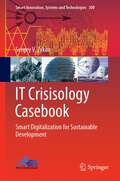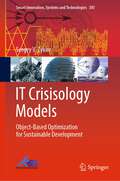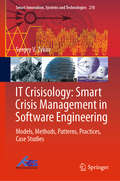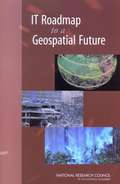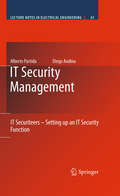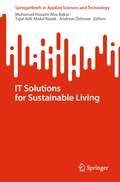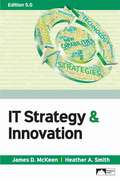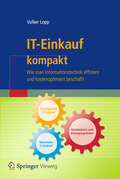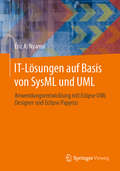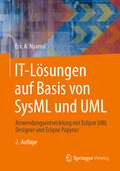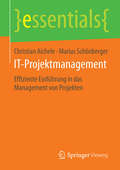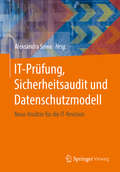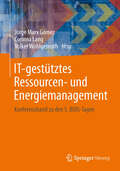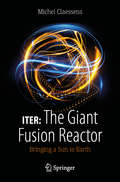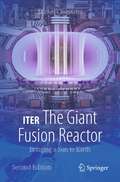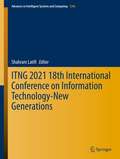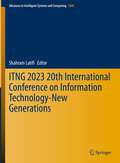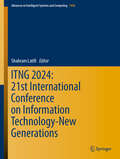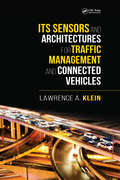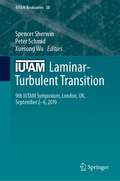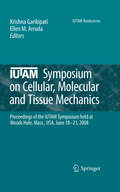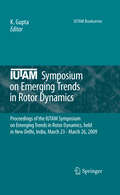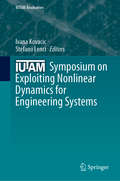- Table View
- List View
IT Crisisology Casebook: Smart Digitalization for Sustainable Development (Smart Innovation, Systems and Technologies #300)
by Sergey V. ZykovThe book focuses on the real-world case-based crisis management in digital product development. This includes forecasting, responding, and agile engineering/management methods, patterns, and practices for sustainable development. This book introduces a set of case studies for sustainability in management as a blend, the components of which have been carefully selected from a few domains adjacent to digital production such as IT-intensive operation, human resource management, and knowledge engineering, to name a few. The key ingredients of this crisis management framework include information management, tradeoff optimization, agile product development, and knowledge transfer. The case studies this book features will help the stakeholders in understanding and identifying the key technology, business, and human factors that may likely result in a digital production crisis, i.e., critically affect the organization outcomes in terms of successful digitalization and sustainable development. These factors are particularly important for the large-scale applications, typically considered very complex in managerial and technological aspects, and, therefore, specifically addressed by the discipline of IT crisisology.
IT Crisisology Models: Object-Based Optimization for Sustainable Development (Smart Innovation, Systems and Technologies #381)
by Sergey V. ZykovThe book focuses on modeling real-world crisis management in digital product development. This includes models and methods for forecasting, responding, and agile engineering/managing for sustainable product development. This book suggests an approach that contains principles, formal models, and semi-formal practice-oriented methods, patterns and techniques to efficiently manage these crises and provide sustainable development. The book also introduces a set of principles, models, and methods for sustainable management as a blend, the components of which have been carefully selected from a few domains adjacent to digital production such as IT-intensive operation, human resource management, and knowledge engineering, to name a few. The key ingredients of this crisis management framework include smart data modeling, trade-off optimizing, agile product controlling, and knowledge transferring.
IT Crisisology: Models, Methods, Patterns, Practices, Case Studies (Smart Innovation, Systems and Technologies #210)
by Sergey V. ZykovThis book focuses on crisis management in software development which includes forecasting, responding and adaptive engineering models, methods, patterns and practices. It helps the stakeholders in understanding and identifying the key technology, business and human factors that may result in a software production crisis. These factors are particularly important for the enterprise-scale applications, typically considered very complex in managerial and technological aspects and therefore, specifically addressed by the discipline of software engineering. Therefore, this book throws light on the crisis responsive, resilient methodologies and practices; therewith, it also focuses on their evolutionary changes and the resulting benefits.
IT Planet - Information Technology Book class 9 (Code - 402) - GSTB
by Davinder Singh MinhasThe book “Information Technology 9” is a comprehensive guide designed for Class 9 students, aligned with the CBSE curriculum. It covers a range of topics essential for building foundational IT skills, including employability skills such as communication and self-management, as well as specific IT competencies like data entry, digital documentation, electronic spreadsheets, and digital presentations. The book adopts a step-by-step approach, integrating theoretical knowledge with practical exercises, real-life projects, and application-based questions, making it an effective resource for students to develop technical skills necessary for future employment.
IT Roadmap to a Geospatial Future
by Information Technology Committee on Intersections Between Geospatial InformationThis report of the National Research Council examines the possibilities and promises of increased interaction between the geospatial and computer science research communities for capitalizing on the increasing complexity and diversity of georeferenced data. The goals of the report are to encourage the performance, accessibility, and usability of geospatial information; to identify how geospatial applications might influence computer science research; and to identify new geospatial applications made possible by recent advancements in computer science. Annotation ©2004 Book News, Inc. , Portland, OR (booknews. com)
IT Security Management
by Alberto Partida Diego AndinaIT securiteers - The human and technical dimension working for the organisation. Current corporate governance regulations and international standards lead many organisations, big and small, to the creation of an information technology (IT) security function in their organisational chart or to the acquisition of services from the IT security industry. More often than desired, these teams are only useful for companies' executives to tick the corresponding box in a certification process, be it ISO, ITIL, PCI, etc. Many IT security teams do not provide business value to their company. They fail to really protect the organisation from the increasing number of threats targeting its information systems. IT Security Management provides an insight into how to create and grow a team of passionate IT security professionals. We will call them "securiteers". They will add value to the business, improving the information security stance of organisations.
IT Solutions for Sustainable Living (SpringerBriefs in Applied Sciences and Technology)
by Andreas Öchsner Muhamad Husaini Abu Bakar Tajul Adli Abdul RazakIn today's dynamic and competitive business environment, industries face numerous challenges related to process optimization, energy consumption, and technological advancements. Efficient management of industrial processes is crucial for maximizing productivity, reducing waste, and ensuring sustainable growth. Similarly, energy consumption and maintenance play a pivotal role in achieving cost-effectiveness and environmental sustainability. Moreover, advancements in technology and engineering have the potential to revolutionize industrial operations and enhance overall performance. This research book provides an analysis of various topics encompassing industrial processes, energy consumption, and technology in engineering management. The book encompasses three main categories. The first category is related to industrial processes, which investigate methodologies and techniques to identify and eliminate waste. The second category is discussing energy consumption and maintenance strategies in industrial and building environments. This section aims to optimize energy usage, reduce costs, and promote sustainable practices. Lastly, the third category in technology and engineering explores advancements in technology and engineering and their applications in industrial settings. This section investigates innovative solutions and techniques to enhance productivity, optimize processes, and improve overall performance. The research book aims to become a valuable resource for researchers, practitioners, and policymakers interested in smart technologies and sustainable living.
IT Strategy and Innovation
by Heather Smith James D. McKeenDesigned for courses where the goal is to understand how IT delivers organizational value, this text can be used in IT Strategy and IT Management courses at the undergraduate and graduate levels. The text combines the experiences and insights of many senior IT managers from leading-edge organizations with thorough academic research to bring important issues in IT management to life and demonstrate how IT strategy is put into action in contemporary businesses. Edition 5.0 is updated with 11 new chapters and 3 new mini cases.
IT-Einkauf kompakt: Wie Man Informationstechnik Effizient Und Kostenoptimiert Beschafft (It Kompakt Ser.)
by Volker LoppIn Zeiten der Digitalisierung, in denen große Datenmengen schnell und effizient verarbeitet werden müssen, steht das IT-Management oft vor einer großen Herausforderung. Um die Kosten gering und effizient zu halten, empfiehlt es sich, bei den Basics anzusetzen. Viele Unternehmen unterschätzen immer noch das Potential eines professionellen und standardisierten IT-Einkaufs. Jedes Unternehmen kann davon enorm profitieren, ganz gleich, ob sie nur im Einzelfall ein größeres Projekt strukturierter angehen wollen oder aber umfangreiche oder ungewöhnliche viele Ausschreibungen zu bewältigen haben. Ein grundsätzliches Überprüfen der bisherigen Verfahren ist immer dann ratsam, wenn die Prozesse verbessert oder die Beschaffungsstrategie überarbeitet werden sollen, wenn die externen Kosten gesenkt werden müssen oder aber ein Unternehmen die Qualität seiner IT-Beratungen und damit das Firmenimage verbessern möchte.Dieses Buch für den IT-Einkauf geht detailliert auf die speziellen Anforderungen für die Beschaffung von Hardware, Software, Dienstleistungen und Cloud-Services ein. Der Autor fasst die wichtigsten Gründe, aus denen ein IT-Einkauf benötigt wird, kompakt zusammen und zeigt, wie sich der IT-Markt aus Sicht des Einkäufers gestaltet. Neben einem ausführlichen Überblick über die Zusammenarbeit mit der IT-Abteilung und der besonderen Bedeutung des Lieferantenmanagements bei den großen Abhängigkeiten in der Informationstechnologie, erläutert der Autor die Wichtigkeit der Stammdaten und wie man ihre Qualität erhöhen kann. Ein Exkurs über das Vertrags- und Lizenzmanagement rundet dieses kompakte Buch ab.Damit ist es der ideale Ratgeber für Einkaufsleiter, IT-Leiter, IT-Einkäufer und die Konzernrevision, da es vom Hard- und Software-Einkauf, über das Mangement von Verträgen, Lizenzen und Lieferanten bis hin zu den eigentliche IT-Ausschreibungen alle wesentlichen Themengebiete des strategischen Einkaufs abdeckt.
IT-Lösungen auf Basis von SysML und UML: Anwendungsentwicklung mit Eclipse UML Designer und Eclipse Papyrus
by Eric A. NyamsiDas Buch fokussiert auf Eclipse UML Designer und Eclipse Papyrus in Bezug auf Erstellen und Visualisierung von UML- und SysML-Diagrammen im Bereich der Stromversorgung. Die visuellen Modellierungs-Entwicklungsumgebungen UML Designer (Obeo Designer) und Papyrus werden dargestellt
IT-Lösungen auf Basis von SysML und UML: Anwendungsentwicklung mit Eclipse UML Designer und Eclipse Papyrus
by Eric A. NyamsiDas Buch fokussiert auf Eclipse-UML-Designer und Eclipse Papyrus in Bezug auf Erstellen und Visualisierung von UML- und SysML-Diagrammen im Bereich der Energietechnik. Die visuellen Modellierungs-Entwicklungsumgebungen UML-Designer (Obeo-Designer) und Papyrus werden dargestellt. Neue Features von Java 16–19 und C++20 werden zum Ermöglichen der Programmierung der Anwendungen für die Energiebranche mittels des Konzepts „Modelling4Programming“ oder „M4P“ erläutert. Jakarta-EE-Platform (Version 9.1) wird zum Erstellen von Enterprise-Anwendungen mithilfe eines Applikationsservers wie Glassfish (Version 6.2.5) dargestellt.
IT-Projektmanagement: Effiziente Einführung in das Management von Projekten (essentials)
by Christian Aichele Marius SchönbergerChristian Aichele und Marius Schönberger haben aktuelle wissenschaftliche Methoden und Praxiserfahrungen aus IT-Projekten in unterschiedlichsten Bereichen und Branchen zusammengefasst. Zur erfolgreichen Durchführung von Projekten stellen sie hierbei aktuelle Methoden und Vorgehensweise kumuliert vor und erklären sie so, dass interessierte Leser ein fundiertes Grundlagenwissen über die Auswahl und den Einsatz passender Methoden des Projektmanagements erhalten.
IT-Prüfung, Sicherheitsaudit und Datenschutzmodell
by Aleksandra SowaDas Buch erläutert leicht verständlich die modernen Grundlagen der Revisionsarbeit. Erstmalig für praktische Anwendung systematisiert, führt es in Systeme der Security Intelligence, kognitiven Sicherheit und Schwarmintelligenz ein. Zudem stellt das Herausgeberwerk eine Anleitung für Prüfer im Umgang mit neuen Themen, wie Standard-Datenschutzmodell (SDM), Sicherheitsaudits in der industriellen Produktion und IoT-Umgebung sowie die Handhabung von Hinweisen zur Wirtschaftskriminalität und zu Compliance-Verstößen in den Jahresabschlussprüfungen vor. Damit können Revisoren diese Themen als systematische Prüfungen, Tests und Audits erfassen und umsetzen.
IT-gestütztes Ressourcen- und Energiemanagement: Konferenzband zu den 5. BUIS-Tagen
by Jorge Marx Gómez Volker Wohlgemuth Corinna LangIn diesem Tagungsband zu den 5. BUIS-Tagen (15. Tagung der Fachgruppe Betriebliche Umweltinformationssysteme der Gesellschaft für Informatik e.V.) werden aktuelle Themen des IT-gestützte Ressourcen- und Energiemanagements präsentiert mit dem Fokus auf: Green IT und Energieeffizienz, Stoffstrommanagement, Green Production, Green Logistics, Nachhaltigkeitsmanagement und Kommunikation, Green Software sowie Materialeffizienz und Recycling. In der "Students Corner" präsentieren Studierende eigene Lösungsansätze aus Projekten und Abschlußarbeiten.
ITER: Bringing a Sun to Earth
by Michel ClaessensThis book provides for the first time an insider’s view into ITER, the biggest fusion reactor in the world, which is currently being constructed in southern France.Aimed at bringing the “energy of the stars” to earth, ITER is funded by the major economic powers (China, the EU, India, Japan, Korea, Russia and the US). Often presented as a “nuclear but green” energy source, fusion could play an important role in the future electricity supply. But as delays accumulate and budgets continue to grow, ITER is currently a star partially obscured by clouds. Will ITER save humanity by providing a clean, safe and limitless source of energy, or is it merely a political showcase of cutting-edge technology? Is ITER merely an ambitious research project and partly a PR initiative driven by some politically connected scientists? In any case, ITER has already helped spur on rival projects in the US, Canada and the UK. This book offers readers a behind-the-scenes look at this controversial project, which France snatched from Japan, and introduces them to a world of superlatives: with the largest magnets in the world, the biggest cryogenic plant and tremendous computing power, ITER is one of the most fascinating, and most international, scientific and technological endeavours of our time.
ITER: Bringing a Sun to Earth (Copernicus Books)
by Michel ClaessensThis book provides for the first time an insider’s view into ITER, the biggest fusion reactor in the world, which is currently being constructed in southern France. Now in its second edition, it updates readers on all developments at ITER and those at competing fusion initiatives worldwide, at the National Ignition Facility (US), the Joint European Torus (EU) and the tens of start-ups funded by private ventures. The author also shares his personal experience with this unique big science project.Aimed at bringing the “energy of the stars” to earth, ITER is funded by the major economic powers (China, the EU, India, Japan, Korea, Russia and the USA). Often presented as a “nuclear but green” energy source, fusion could play an important role in the future electricity supply. But as delays accumulate and budgets continue to grow, ITER is currently a star partially obscured by clouds. Will ITER save humanity by providing a clean, safe and limitless source of energy, or is it merely a political showcase of cutting-edge technology? Is ITER merely an ambitious research project and partly a PR initiative driven by some politically connected scientists? In any case, ITER has already helped spur on rival projects in the USA, Canada and the UK. This book offers readers a behind-the-scenes look at this controversial project, which France snatched from Japan, and introduces them to a world of superlatives: with the largest magnets in the world, the biggest cryogenic plant and tremendous computing power, ITER is one of the most fascinating, and most international, scientific and technological endeavours of our time.
ITNG 2021 18th International Conference on Information Technology-New Generations (Advances in Intelligent Systems and Computing #1346)
by Shahram LatifiThis volume represents the 18th International Conference on Information Technology - New Generations (ITNG), 2021. ITNG is an annual event focusing on state of the art technologies pertaining to digital information and communications. The applications of advanced information technology to such domains as astronomy, biology, education, geosciences, security, and health care are the among topics of relevance to ITNG. Visionary ideas, theoretical and experimental results, as well as prototypes, designs, and tools that help the information readily flow to the user are of special interest. Machine Learning, Robotics, High Performance Computing, and Innovative Methods of Computing are examples of related topics. The conference features keynote speakers, a best student award, poster award, service award, a technical open panel, and workshops/exhibits from industry, government and academia. This publication is unique as it captures modern trends in IT with a balance of theoretical and experimental work. Most other work focus either on theoretical or experimental, but not both. Accordingly, we do not know of any competitive literature.
ITNG 2023 20th International Conference on Information Technology-New Generations (Advances in Intelligent Systems and Computing #1445)
by Shahram LatifiThis volume represents the 20th International Conference on Information Technology - New Generations (ITNG), 2023. ITNG is an annual event focusing on state of the art technologies pertaining to digital information and communications. The applications of advanced information technology to such domains as astronomy, biology, education, geosciences, security, and health care are the among topics of relevance to ITNG. Visionary ideas, theoretical and experimental results, as well as prototypes, designs, and tools that help the information readily flow to the user are of special interest. Machine Learning, Robotics, High Performance Computing, and Innovative Methods of Computing are examples of related topics. The conference features keynote speakers, a best student award, poster award, service award, a technical open panel, and workshops/exhibits from industry, government and academia. This publication is unique as it captures modern trends in IT with a balance of theoretical and experimental work. Most other work focus either on theoretical or experimental, but not both. Accordingly, we do not know of any competitive literature.
ITNG 2024: 21st International Conference on Information Technology-New Generations (Advances in Intelligent Systems and Computing #1456)
by Shahram LatifiThis volume represents the 21st International Conference on Information Technology - New Generations (ITNG), 2024. ITNG is an annual event focusing on state of the art technologies pertaining to digital information and communications. The applications of advanced information technology to such domains as astronomy, biology, education, geosciences, security, and health care are the among topics of relevance to ITNG. Visionary ideas, theoretical and experimental results, as well as prototypes, designs, and tools that help the information readily flow to the user are of special interest. Machine Learning, Robotics, High Performance Computing, and Innovative Methods of Computing are examples of related topics. The conference features keynote speakers, a best student award, poster award, service award, a technical open panel, and workshops/exhibits from industry, government and academia. This publication is unique as it captures modern trends in IT with a balance of theoretical and experimental work. Most other work focus either on theoretical or experimental, but not both. Accordingly, we do not know of any competitive literature.
ITS Sensors and Architectures for Traffic Management and Connected Vehicles
by Lawrence A. KleinAn intelligent transportation system (ITS) offers considerable opportunities for increasing the safety, efficiency, and predictability of traffic flow and reducing vehicle emissions. Sensors (or detectors) enable the effective gathering of arterial and controlled-access highway information in support of automatic incident detection, active transportation and demand management, traffic-adaptive signal control, and ramp and freeway metering and dispatching of emergency response providers. As traffic flow sensors are integrated with big data sources such as connected and cooperative vehicles, and cell phones and other Bluetooth-enabled devices, more accurate and timely traffic flow information can be obtained. The book examines the roles of traffic management centers that serve cities, counties, and other regions, and the collocation issues that ensue when multiple agencies share the same space. It describes sensor applications and data requirements for several ITS strategies; sensor technologies; sensor installation, initialization, and field-testing procedures; and alternate sources of traffic flow data. The book addresses concerns related to the introduction of automated and connected vehicles, and the benefits that systems engineering and national ITS architectures in the US, Europe, Japan, and elsewhere bring to ITS. Sensor and data fusion benefits to traffic management are described, while the Bayesian and Dempster–Shafer approaches to data fusion are discussed in more detail. ITS Sensors and Architectures for Traffic Management and Connected Vehicles suits the needs of personnel in transportation institutes and highway agencies, and students in undergraduate or graduate transportation engineering courses.
IUTAM Laminar-Turbulent Transition: 9th IUTAM Symposium, London, UK, September 2–6, 2019 (IUTAM Bookseries #38)
by Peter Schmid Spencer Sherwin Xuesong WuThis volume comprises the carefully revised papers of the 9th IUTAM Symposium on Laminar-Turbulent Transition, held at the Imperial College, London, UK, in September 2019. The papers focus on the leading research in understanding transition to turbulence, which is a challenging topic of fluid mechanics and arises in many modern technologies as well as in nature. The proceedings are of interest for researchers in fluid mechanics and industry who have to handle these types of problems, such as in the aeronautical sector.
IUTAM Symposium on Cellular, Molecular and Tissue Mechanics
by Ellen M. Arruda Krishna GarikipatiThese Proceedings reflect the state of current understanding of the role played by mechanics in biological systems at the molecular, cellular and tissue levels. The invited papers will be notable for the expressed viewpoints of biologists, biophysicists and mechanicians. The topics addressed will range from tissue engineering and tissue mechanics, through cell mechanics, down to the mechanics of biomolecules.
IUTAM Symposium on Emerging Trends in Rotor Dynamics
by K. GuptaRotor dynamics is an important branch of dynamics that deals with behavior of rotating machines ranging from very large systems like power plant rotors, for example, a turbogenerator, to very small systems like a tiny dentist's drill, with a variety of rotors such as pumps, compressors, steam/gas turbines, motors, turbopumps etc. as used for example in process industry, falling in between. The speeds of these rotors vary in a large range, from a few hundred RPM to more than a hundred thousand RPM. Complex systems of rotating shafts depending upon their specific requirements, are supported on different types of bearings. There are rolling element bearings, various kinds of fluid film bearings, foil and gas bearings, magnetic bearings, to name but a few. The present day rotors are much lighter, handle a large amount of energy and fluid mass, operate at much higher speeds, and therefore are most susceptible to vibration and instability problems. This have given rise to several interesting physical phenomena, some of which are fairly well understood today, while some are still the subject of continued investigation. Research in rotor dynamics started more than one hundred years ago. The progress of the research in the early years was slow. However, with the availability of larger computing power and versatile measurement technologies, research in all aspects of rotor dynamics has accelerated over the past decades. The demand from industry for light weight, high performance and reliable rotor-bearing systems is the driving force for research, and new developments in the field of rotor dynamics. The symposium proceedings contain papers on various important aspects of rotor dynamics such as, modeling, analytical, computational and experimental methods, developments in bearings, dampers, seals including magnetic bearings, rub, impact and foundation effects, turbomachine blades, active and passive vibration control strategies including control of instabilities, nonlinear and parametric effects, fault diagnostics and condition monitoring, and cracked rotors. This volume is of immense value to teachers, researchers in educational institutes, scientists, researchers in R&D laboratories and practising engineers in industry.
IUTAM Symposium on Exploiting Nonlinear Dynamics for Engineering Systems (IUTAM Bookseries #37)
by Stefano Lenci Ivana KovacicThis is the proceedings of the IUTAM Symposium on Exploiting Nonlinear Dynamics for Engineering Systems that was held in Novi Sad, Serbia, from July 15th to 19th, 2018. The appearance of nonlinear phenomena used to be perceived as dangerous, with a general tendency to avoid them or control them. This perception has led to intensive research using various approaches and tailor-made tools developed over decades. However, the Nonlinear Dynamics of today is experiencing a profound shift of paradigm since recent investigations rely on a different strategy which brings good effects of nonlinear phenomena to the forefront. This strategy has a positive impact on different fields in science and engineering, such as vibration isolation, energy harvesting, micro/nano-electro-mechanical systems, etc. Therefore, the ENOLIDES Symposium was devoted to demonstrate the benefits and to unlock the potential of exploiting nonlinear dynamical behaviour in these but also in other emerging fields of science and engineering.This proceedings is useful for researchers in the fields of nonlinear dynamics of mechanical systems and structures, and in Mechanical and Civil Engineering.
IUTAM Symposium on Model Order Reduction of Coupled Systems, Stuttgart, Germany, May 22–25, 2018: MORCOS 2018 (IUTAM Bookseries #36)
by Jörg Fehr Bernard HaasdonkThis volume contains the proceedings of the IUTAM Symposium on Model Order Reduction of Coupled System, held in Stuttgart, Germany, May 22–25, 2018. For the understanding and development of complex technical systems, such as the human body or mechatronic systems, an integrated, multiphysics and multidisciplinary view is essential. Many problems can be solved within one physical domain. For the simulation and optimization of the combined system, the different domains are connected with each other. Very often, the combination is only possible by using reduced order models such that the large-scale dynamical system is approximated with a system of much smaller dimension where the most dominant features of the large-scale system are retained as much as possible. The field of model order reduction (MOR) is interdisciplinary. Researchers from Engineering, Mathematics and Computer Science identify, explore and compare the potentials, challenges and limitations of recent and new advances.
